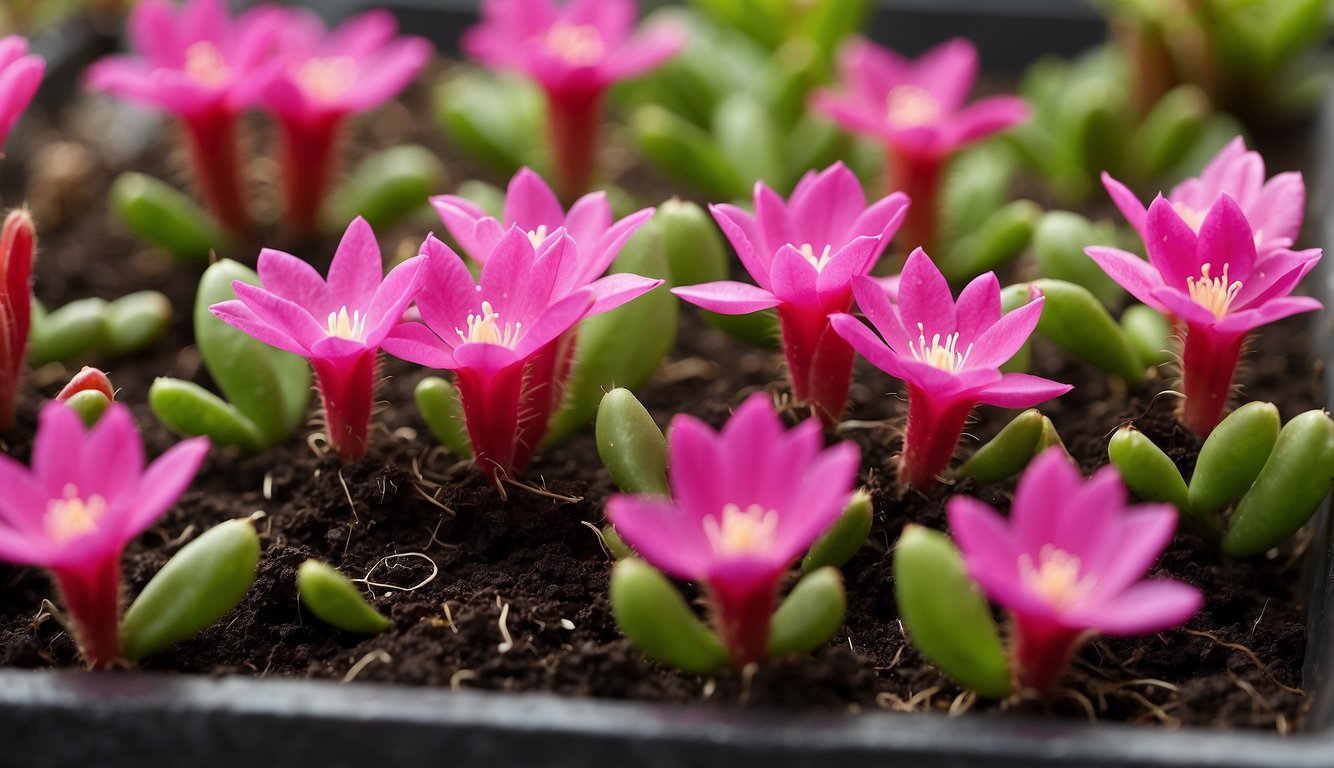TheHerbProf.com is a treasure trove of knowledge for those interested in natural healing and herbal remedies. The website is run by Paul Johnston MD. A naturopathic who has not only received extensive education in the field but also has personal experience in self-healing.
If you’re a plant lover, you’ve probably heard of Thanksgiving cactus, a beautiful and easy-to-grow houseplant that blooms around the holidays. But did you know that propagating Thanksgiving cactus is simple too? In this article, I will share with you how to propagate Thanksgiving cactus so that you can have more of this lovely plant in your home.
There are three common ways to propagate Thanksgiving cactus: water propagation, soil propagation, and division. Each method has its advantages and disadvantages, and the best one for you depends on your preferences and the resources you have. In the next section, I will describe each method in detail and give you step-by-step instructions on how to propagate Thanksgiving cactus using that method.
Understanding Thanksgiving Cactus
As a succulent plant, the Thanksgiving cactus (Schlumbergera truncata) is native to the coastal mountains of southeastern Brazil. It is a popular houseplant that is easy to care for and propagate. In this section, I will cover the characteristics of Schlumbergera truncata and the differences between holiday cacti.
Characteristics of Schlumbergera Truncata
Thanksgiving cacti have flat, segmented leaves that are connected by a midrib. The leaves have small, hair-like structures called areoles that produce flowers. The flowers bloom from the tips of the leaves and usually appear in late fall, just in time for Thanksgiving. The blooms are usually pink, red, or white, and can last for several weeks.
The Thanksgiving cactus is a low-maintenance plant that prefers bright, indirect light and well-draining soil. It can also tolerate some shade and cooler temperatures. It is important to avoid overwatering the plant, as it can cause root rot. Instead, water the plant only when the top inch of soil is dry to the touch.
Differences Between Holiday Cacti – How to Propagate Thanksgiving Cactus?
The Thanksgiving cactus is one of three popular holiday cacti, the other two being the Christmas cactus (Schlumbergera bridgesii) and the Easter cactus (Hatiora gaertneri). While all three plants are similar in appearance and care, they have some distinct differences.
The Thanksgiving cactus is known for its pointed, claw-like projections on the edges of its leaves, while the Christmas cactus has rounded, scalloped edges. The Easter cactus has more rounded and elongated leaves than the other two. Additionally, the Thanksgiving cactus blooms in late fall, the Christmas cactus blooms in winter, and the Easter cactus blooms in spring.
Understanding the characteristics of Schlumbergera truncata and the differences between holiday cacti is important for successfully propagating these plants.
Preparation for Propagation
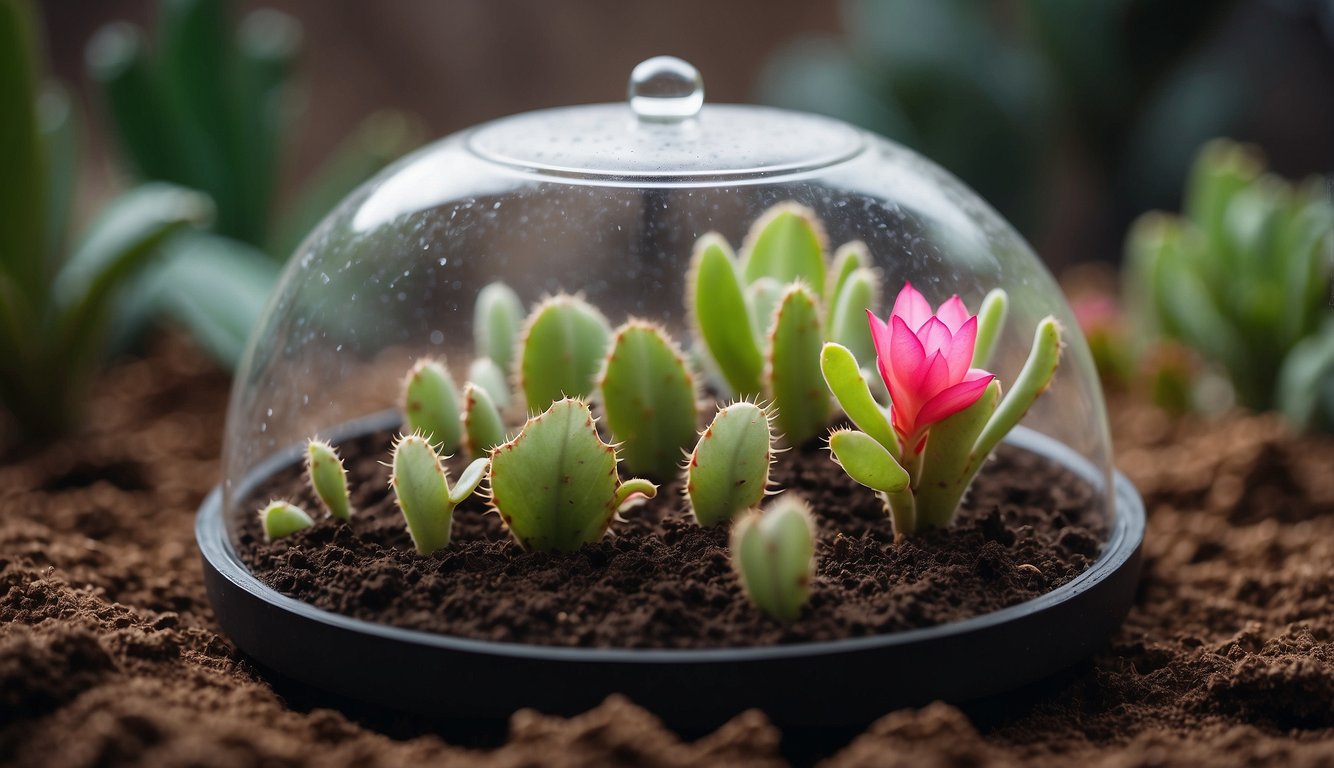
Propagating a Thanksgiving cactus is an easy and rewarding process. However, it requires a bit of preparation to ensure success. In this section, I will guide you through the necessary steps to prepare for propagating your Thanksgiving cactus.
Choosing the Right Time
The best time to propagate a Thanksgiving cactus is in the spring or early summer when the plant is actively growing. This is when the plant is most likely to produce new growth, which will eventually develop into a new plant.
Selecting a Healthy Parent Plant
To ensure that your new plant grows strong and healthy, it’s important to select a healthy parent plant. Look for a plant that has no signs of disease or pests and is growing vigorously. A healthy plant will have plump, green leaves and a firm stem.
Gathering Necessary Tools and Materials
Before you begin propagating your Thanksgiving cactus, you’ll need to gather a few tools and materials. Here is a list of what you’ll need:
- A sharp knife or scissors
- Potting mix or potting soil
- Perlite (optional)
- A pot with a drainage hole
- A jar or plastic wrap (optional)
A sharp knife or scissors will allow you to make clean cuts without damaging the parent plant. Potting mix or potting soil will provide the necessary nutrients for your new plant to grow. Perlite can be added to the potting mix to improve drainage. A pot with a drainage hole will ensure that excess water can escape, preventing root rot. A jar or plastic wrap can be used to create a mini greenhouse, which will help your new plant retain moisture and humidity.
With these tools and materials, you’ll be well-prepared to propagate your Thanksgiving cactus. In the next section, I will guide you through the steps to take when propagating your plant.
Propagation Techniques – How to Propagate Thanksgiving Cactus?
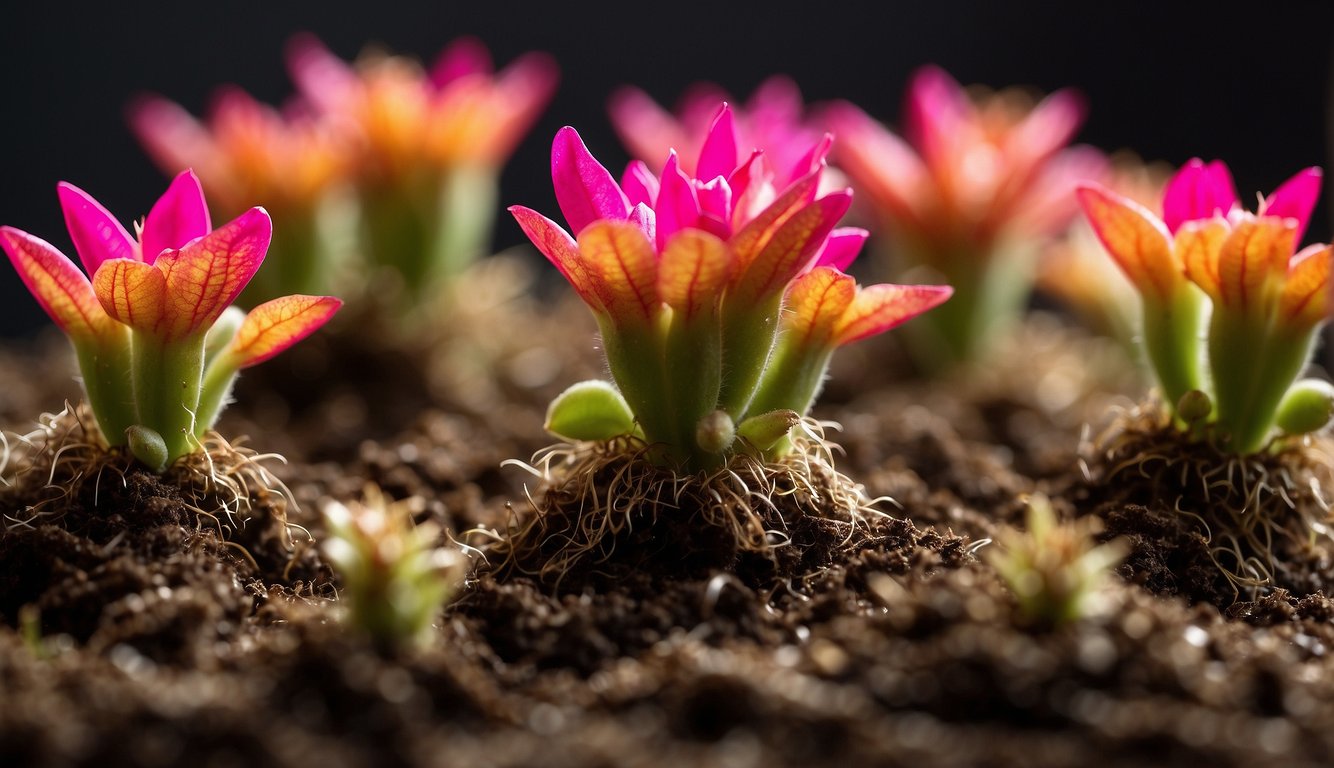
Thanksgiving cactus is a beautiful plant that can be propagated through various methods. In this section, I will discuss two of the most common propagation techniques: stem cuttings and division.
Stem Cuttings Method
Stem cuttings are the most popular and easiest way to propagate Thanksgiving cactus. To begin, select a healthy stem and cut it into segments that are about 3-4 inches long. Make sure each segment has at least two or three segments.
Next, let the cuttings dry for a few days to allow the wound to heal. After the cuttings have dried, dip the cut end in rooting hormone powder to encourage rooting. Then, plant the cuttings in a pot filled with a well-draining soil mix.
Water the soil thoroughly and place the pot in a location that receives bright, indirect sunlight. Continue to water the cuttings periodically and wait for them to form new growth, which can take several weeks.
Division Method – How to Propagate Thanksgiving Cactus?
Another way to propagate Thanksgiving cactus is through division. This method is ideal if you have an already thriving plant that you want to propagate.
To begin, remove the plant from its pot and gently separate the stems from the roots. Make sure each stem has a few healthy roots attached.
Next, plant each stem in a pot filled with a well-draining soil mix. Water the soil thoroughly and place the pot in a location that receives bright, indirect sunlight. Continue to water the plants periodically and wait for them to form new growth.
Propagation by division is quicker than stem cuttings, but it can be more challenging since you need to make sure each stem has enough roots to survive on its own.
In summary, both stem cuttings and division are effective methods to propagate Thanksgiving cactus. Stem cuttings are easier and more reliable, while division is quicker but requires more care. With the right technique and care, you can successfully propagate your Thanksgiving cactus and enjoy a new plant in no time.
Executing the Propagation – How to Propagate Thanksgiving Cactus?

Once you have prepared the materials, it’s time to execute the propagation. This process involves three main steps: making the cut, rooting the cuttings, and potting the new plant.
Making the Cut
Using a sharp, clean pair of scissors or gardening shears, cut a section of the Thanksgiving cactus stem that is at least two to three segments long. Make sure to cut at a 45-degree angle to increase the surface area for rooting.
After you have made the cut, allow the cutting to dry and callus over for a few days. This will help prevent the cutting from rotting when rooting.
Rooting the Cuttings
Once the cutting has callused over, dip the cut end into rooting hormone powder. This step is optional, but it can enhance the rooting success of the cutting.
Next, place the cutting in a pot with well-draining soil mix. Make sure the pot has drainage holes to prevent water from accumulating at the bottom. You can also add a layer of pebbles at the bottom of the pot to improve drainage.
Water the soil lightly, and place the pot in a bright indirect light spot. The cutting should not be exposed to direct sunlight, as this can cause the cutting to dry out.
Potting the New Plant – How to Propagate Thanksgiving Cactus?
After a few weeks, new growth should appear from the cutting. This indicates that the cutting has successfully rooted and is ready to be potted.
Gently remove the rooted cutting from the pot and transplant it into a larger pot with fresh soil mix. Make sure to keep the plant in a humid environment, as Thanksgiving cacti thrive in high humidity.
In summary, propagating a Thanksgiving cactus involves making the cut, rooting the cuttings, and potting the new plant. By following these steps and providing the right conditions, you can successfully propagate your Thanksgiving cactus and enjoy a beautiful new plant.
Post-Propagation Care

Congratulations on successfully propagating your Thanksgiving cactus! Now it’s time to take care of your new plants to ensure they thrive. Here are some tips on how to care for your propagated Thanksgiving cactus.
Watering and Feeding – How to Propagate Thanksgiving Cactus?
After propagating your Thanksgiving cactus, it’s important to water it properly. Water the soil thoroughly and allow it to drain before placing it back in its location. Make sure the soil is moist but not too wet, as too much water can cause the roots to rot. During the growing season, water the plant once a week and reduce watering during the dormant season.
Fertilizing your Thanksgiving cactus is also important for its growth and blooming. Use a balanced fertilizer every two weeks during the growing season, and stop fertilizing during the dormant season.
Managing Light and Temperature
Thanksgiving cacti prefer bright, indirect sunlight. Place your propagated plants in a location that receives bright, indirect sunlight for most of the day. Avoid direct sunlight, as it can burn the leaves. During the dormant season, place the plant in a cooler location with less light.
Thanksgiving cacti also prefer cooler temperatures. Keep the temperature between 60°F to 70°F during the growing season and between 50°F to 60°F during the dormant season.
Pruning and Maintenance
Pruning your Thanksgiving cactus is important for maintaining its shape and promoting blooming. Use clean pruning shears to remove any dead or diseased branches, and prune back the tips of the branches to encourage branching and blooming.
Repotting your Thanksgiving cactus is also important for its growth and health. Repot the plant every two to three years to refresh the soil and provide more space for its roots to grow. Use a well-draining soil mix formulated for cacti and succulents.
By following these tips, you can ensure that your propagated Thanksgiving cactus stays healthy and blooms beautifully.
Troubleshooting Common Problems
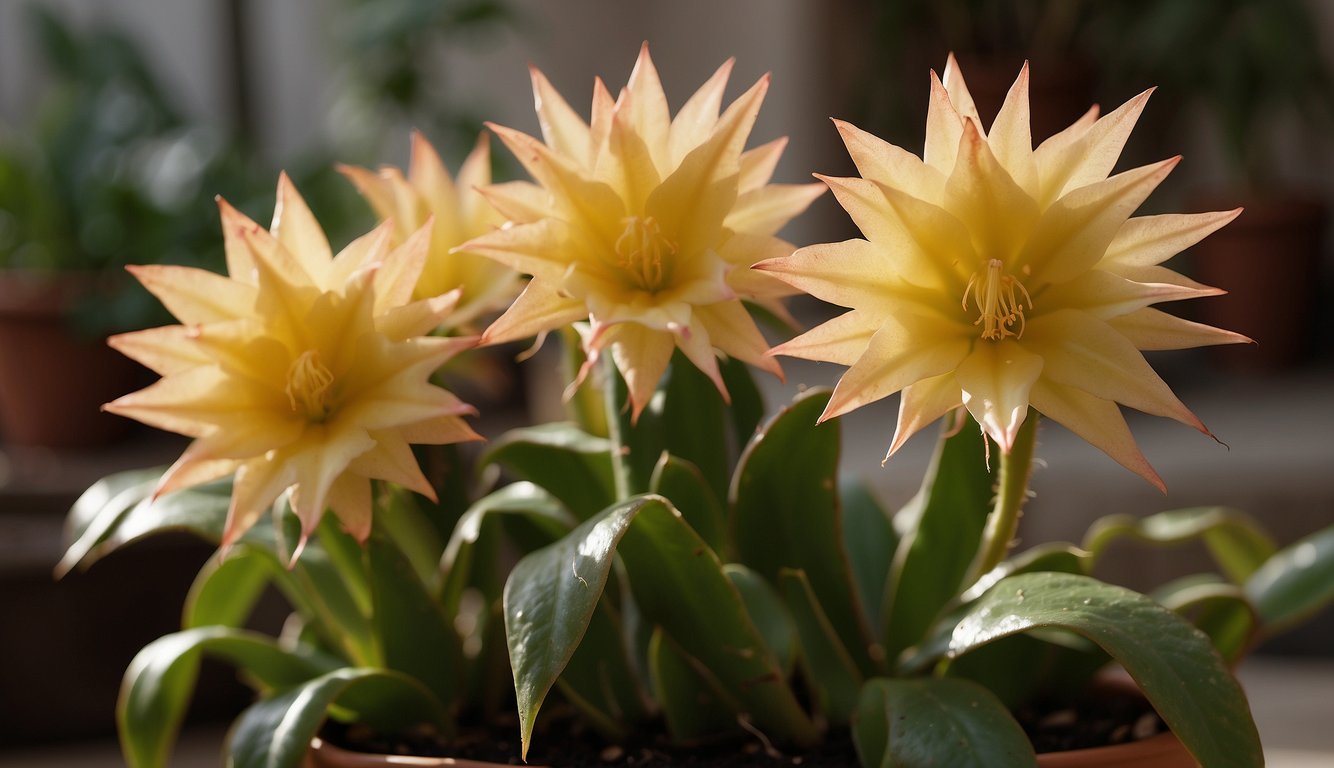
Thanksgiving cacti are generally problem-free and easy to propagate. However, there are some common issues that you may encounter during the propagation process. In this section, I will discuss some of the most common problems and how to deal with them.
Dealing with Rotting and Disease – How to Propagate Thanksgiving Cactus?
Rotting is one of the most common problems that you may encounter when propagating Thanksgiving cacti. This can occur when the plant is overwatered or when the soil is not well-draining. To prevent rotting, make sure that you use well-draining soil and avoid overwatering the plant. If you notice any signs of rotting, such as soft or discolored stems, remove the affected parts immediately. You can also treat the plant with a fungicide to prevent the spread of disease.
Preventing Overwatering
Overwatering is another common problem that can affect Thanksgiving cacti. This can lead to root rot and stem rot, which can cause the plant to wilt and die. To prevent overwatering, make sure that you water the plant only when the soil is dry to the touch. You can also use a moisture meter to check the soil moisture level. If the soil is too wet, allow it to dry out before watering the plant again.
Encouraging Successful Blooming
Thanksgiving cacti are known for their beautiful blooms, which can range in color from white to pink to red. However, getting the plant to bloom can be a challenge. To encourage successful blooming, make sure that the plant is getting enough light. Thanksgiving cacti require bright, indirect light to bloom. You can also fertilize the plant every two weeks with a balanced fertilizer to encourage new growth and blooming. Finally, make sure that the plant is calloused over before planting it in soil. This will help to prevent rotting and encourage successful rooting.
Multiplying Your Thanksgiving Cactus Collection
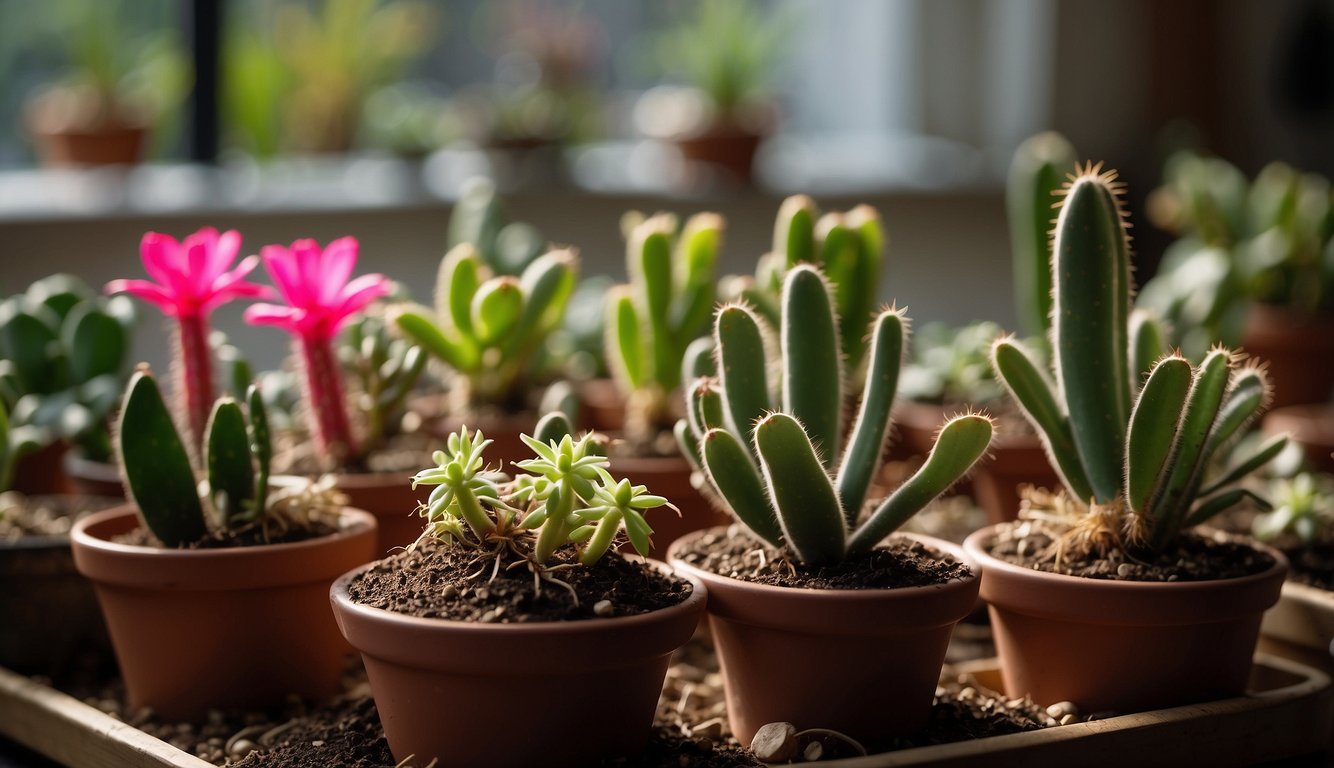
If you’re a fan of Thanksgiving cacti and want to expand your collection, propagating your existing plants is a great way to do so. There are a few different methods you can use to multiply your Thanksgiving cactus, but in this section, I’ll cover two of the most popular: using multiple cuttings and creating a favorable environment for new plants.
Using Multiple Cuttings – How to Propagate Thanksgiving Cactus?
One of the easiest ways to multiply your Thanksgiving cactus is to take multiple cuttings from a single plant. This method is especially useful if you have a large, healthy plant that you want to reproduce.
To use multiple cuttings, start by selecting a healthy, mature plant with several stems. Using a clean, sharp knife or pair of scissors, cut off several stems, making sure to leave at least two or three segments on each stem.
Once you have your cuttings, you can either root them in water or soil. If you choose to root them in water, place the cuttings in a container filled with water and change the water every few days to keep it fresh. If you prefer to root them in soil, plant them in a well-draining potting mix and keep the soil moist but not waterlogged.
Creating a Favorable Environment – How to Propagate Thanksgiving Cactus?
Another way to multiply your Thanksgiving cactus is to create a favorable environment for new plants to grow. This method is especially useful if you don’t want to take cuttings from an existing plant.
To create a favorable environment, start by selecting a bright, indirect location for your new plant. Thanksgiving cacti prefer bright light, but direct sunlight can be too harsh and cause damage to the plant.
Next, make sure the temperature is warm and consistent. Thanksgiving cacti are tropical plants and prefer temperatures between 60 and 70 degrees Fahrenheit.
Finally, make sure the humidity is high. You can increase the humidity by placing a tray of water near the plant or by misting the plant with water regularly.
By following these tips, you can successfully multiply your Thanksgiving cactus collection and enjoy these beautiful houseplants all year round.
Connecting the Dots: Propagating Thanksgiving Cactus and The Herb Prof
Let’s dive into the fascinating world of the Thanksgiving Cactus. Now, you might be wondering, what’s the connection between propagating a Thanksgiving Cactus and our beloved home, theherbprof.com? Well, let’s unravel this mystery together!
Firstly, the Thanksgiving Cactus is a unique plant that brings joy to our homes during the holiday season. It’s a symbol of resilience and beauty. Just like the cactus, theherbprof.com stands tall, providing a wealth of knowledge on herbs and their benefits.
Secondly, the process of propagating a Thanksgiving Cactus is a journey of patience and care. It’s about nurturing a small cutting into a full-grown plant. Similarly, theherbprof.com nurtures your curiosity about herbs, helping it grow into a deep understanding and appreciation.
Lastly, both the Thanksgiving Cactus and theherbprof.com share a common goal: to enrich our lives. The cactus does this by adding a touch of nature to our homes, while theherbprof.com does it by educating us about the power of herbs.
So, there you have it! The Thanksgiving Cactus and theherbprof.com are more connected than you might think. They both represent growth, resilience, and the beauty of nature. Now, isn’t that a fun fact to share at your next garden party? Happy gardening, folks!
References – How to Propagate Thanksgiving Cactus?
Little Herb Encyclopedia, by Jack Ritchason; N.D., Woodland Publishing Incorporated, 1995
The Ultimate Healing System, Course Manual, Copyright 1985, Don Lepore
Planetary Herbology, Michael Tierra, C.A., N.D., Lotus Press, 1988
Handbook of Medicinal Herbs, by James A. Duke, Pub. CRP Second Edition 2007
The Complete Medicinal Herbal, by Penelope Ody, Published by Dorling Kindersley
Check the Following Articles!
Best Rooting Hormone Powder: Plant Propagation Top Picks
Can You Compost Avocado Pits? Let’s Dig In!
Garden Tower 2 Review: The Vertical Gardening System
Frequently Asked Questions – How to Propagate Thanksgiving Cactus?
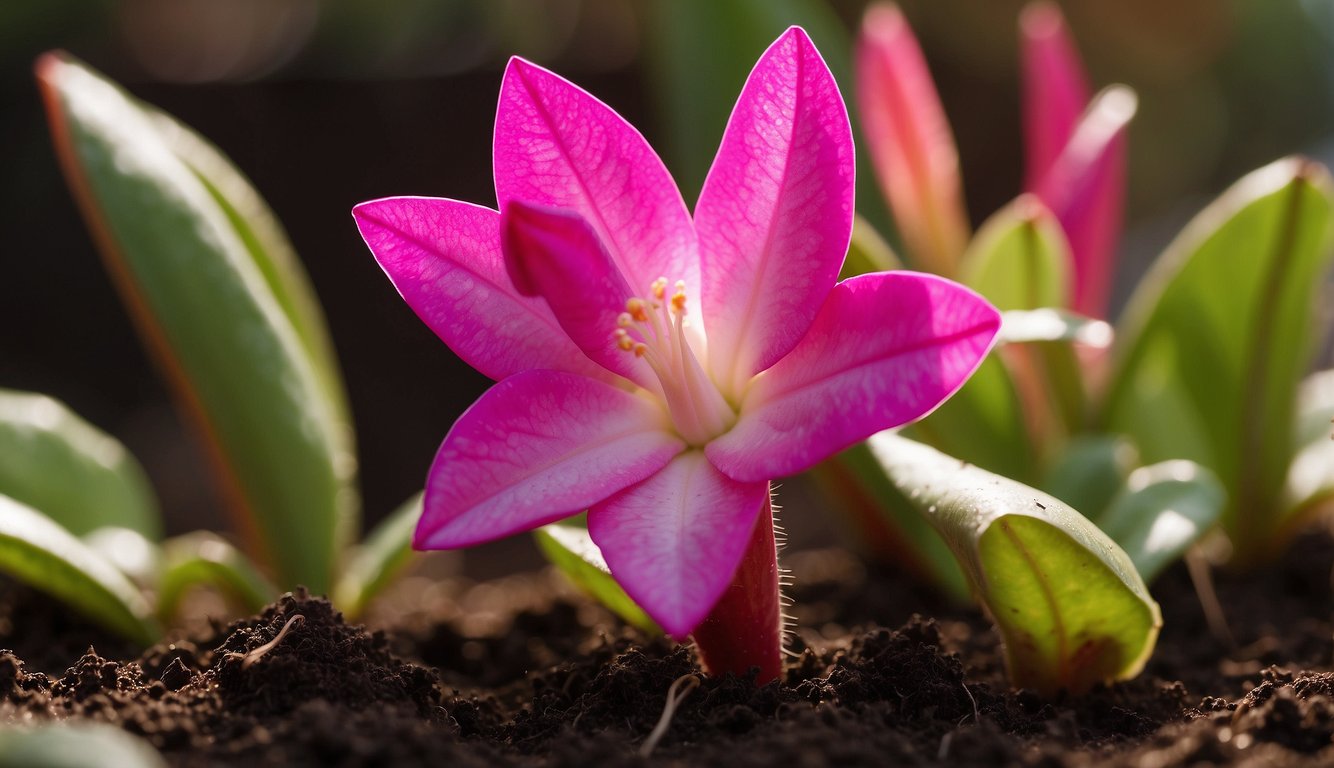
What are the steps for propagating a Thanksgiving cactus in water?
To propagate a Thanksgiving cactus in water, you will need to take a cutting from the plant and place it in a jar or vase filled with water. Make sure that the cutting has at least one segment and let it sit in the water until it starts to develop roots. Once the roots are at least an inch long, you can transplant the cutting into soil. Be sure to change the water every few days to prevent bacteria growth.
What type of soil is best for rooting Thanksgiving cactus cuttings?
A well-draining soil mix is best for rooting Thanksgiving cactus cuttings. A mix of peat moss, perlite, and orchid bark is recommended. This type of soil will allow for proper drainage and aeration, which is essential for healthy root growth.
How can you encourage a Thanksgiving cactus to bloom?
Thanksgiving cacti are triggered to bloom by changes in temperature and light. To encourage your cactus to bloom, make sure it is getting enough sunlight and keep it in a location where the temperature ranges between 60 and 70 degrees Fahrenheit. Additionally, make sure to reduce watering in the fall to help stimulate blooming.
What is the proper technique for pruning a Thanksgiving cactus?
Pruning a Thanksgiving cactus is simple. Use a clean, sharp pair of scissors to cut off any dead or damaged segments. You can also prune the plant to shape it or to control its size. Be sure to sterilize your scissors before and after pruning to prevent the spread of disease.
Is it possible to grow a new Thanksgiving cactus from a cutting?
Yes, it is possible to grow a new Thanksgiving cactus from a cutting. Simply take a cutting from the plant and follow the propagation steps outlined earlier. With proper care, the cutting should develop roots and grow into a new plant.
How do you properly divide a Thanksgiving cactus for propagation?
Dividing a Thanksgiving cactus is a great way to propagate the plant. To do so, gently remove the cactus from its pot and separate the segments. Make sure that each segment has at least two or three segments. Plant each segment in a well-draining soil mix and water thoroughly. Keep the soil moist until the plant has established roots.
